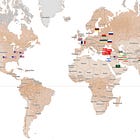The Royal Navy's First Laser Weapon Is Officially Headed to the Fleet
The UK is poised to become the first European country to field a shipboard high-energy laser weapon.

After nearly a decade of research and development, the UK Royal Navy’s high-energy laser weapon just took a major step towards operational employment.
The UK Ministry of Defense announced on Thursday that it had officially awarded European defense giant MBDA a £316 million ($413 million) contract to outfit a Royal Navy Type 45 guided-missile destroyer with the service’s first 50 kilowatt ‘DragonFire’ naval laser weapon by 2027 — an installation that, once complete, would make the system “the first high-power laser capability entering service from a European nation,” according to the MoD.
The new contract follows DragonFire’s successful downing of several drones flying at speeds of up to 650 kilometers an hour (400 miles per hour) during recent trials at the Hebrides military testing range in Scotland, according to the MoD. Those trials followed earlier testing where the system reportedly downed 30 drones and demonstrated “consistency and reliability” in “adverse weather conditions,” as the government put it in July.
“This high-power laser will see our Royal Navy at the leading edge of innovation in NATO, delivering a cutting-edge capability to help defend the UK and our allies in this new era of threat,” UK Minister for Defence Readiness and Industry Luke Pollard, MP, said in a statement.
Watch the UK’s ‘DragonFire’ laser weapon shoot down drones during testing:
In development by a British consortium of MBDA and defense contractors Leonardo and QinetiQ since 2017, DragonFire is designed to counter the rapidly expanding threat of low-cost weaponized drones, as well as conventional weapons like rockets and missiles. A tender notice published by the UK government in June previously indicated that the MoD planned on spending £240 million ($324 million) on the Royal Navy’s first two systems.
The landmark contract comes amid increasing interest among UK military officials in adopting directed energy weapons to counter the rising drone threat. The MoD had in March announced plans to outfit four destroyers with DragonFire systems by 2027 after previously moving up the timeline for the integration of a single system by five years from 2032. In June, the UK’s latest Strategic Defence Review outlined plans to eventually evolve the Royal Navy’s Type 45 destroyers into “minimally crewed or autonomous air dominance systems” capable of hosting directed energy weapons like DragonFire.
The contract also comes amid the acceleration of several naval laser weapon initiatives around the world:
The US Navy is actively testing a shipboard laser weapon system in the Red Sea amid ongoing concerns surrounding the 60 kw High Energy Laser with Integrated Optical Dazzler and Surveillance (HELIOS) installed aboard the Arleigh Burke-class destroyer USS Preble
China’s People’s Liberation Army Navy is slowly but surely installing its newly-unveiled LY-1 naval laser weapon aboard Type 071 amphibious landing ships
Germany’s shipboard laser weapon system, currently in development by MBDA and defense contractor Rheinmetall, “could be available” for operational employment aboard a German Navy warship by 2029
France successfully tested the HELMA-P laser weapon demonstrator developed by defense contractor CILAS aboard the Horizon-class air defense destroyer Forbin in 2023
Australian defense contractor Electro Optic Systems (EOS) is developing a naval variant of the 100 kw “Apollo” laser weapon system the company just sold to the Netherlands for maritime operations
Israeli defense contractor Rafael has confirmed that it is preparing a naval variant of the combat-tested Iron Beam laser weapon for sea trials aboard an Israeli Navy’s Sa’ar 6-class corvette
Japanese defense contractor Kawasaki Heavy Industries recently unveiled a naval directed energy weapon concept at DSEI Japan 2025 designed for integration into Japanese Maritime Self-Defense Force destroyers
The Italian Navy is actively working with MBDA and Leonardo to develop a counter-drone directed energy weapon for use in both existing and next-generation warships
Time will tell how effectively these shipboard systems actually perform at sea. As Laser Wars has previously reported, naval lasers must contend with a variety of maritime-specific challenges, from platform movement and beam jitter to atmospheric obscurants like humidity and sea spray, not to mention the considerable power and cooling requirements for consistent high-intensity combat operations.
But despite these challenges, the new DragonFire contract represents a clear signal: the UK is no longer treating laser weapons as experimental tech, but as an operational capability worth betting on. With the system now backed by a significant budgetary commitment and slated for deployment within two years, the MoD is elevating directed energy from the lab to the fleet and putting the Royal Navy on a fast track toward real-world integration. After years of incremental R&D, the MoD clearly sees laser weapons as a relatively near-term solution to the tactical and economic pressures created by the cheap drones that have transformed global battlefields from Ukraine to the Red Sea.
If DragonFire proves reliable, scalable, and affordable, it won’t just put shipboard laser weapons on the map — it could make the UK a blueprint for how navies arm their fleets for the age of drone warfare.



